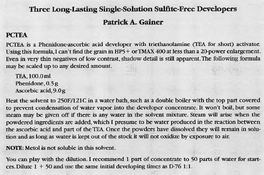Well, it's kind of personal, but yes, I would still say the same for replenished XTOL. It may work fine with most XTOL variants you buy, but the complaints about XTOL and XTOL clones performing oddly (or not at all) and people swearing to only stick with brand X because they bumped their head too many times with brand Y are just too numerous. Combine this with the fact we don't know how frequent or intermittent OP's use will be, and I'd frankly not trust a replenished batch of XTOL if it has sat around idle for a few months (hey, life gets in the way, things happen etc.) Then there's the inherent issue of different films affecting a replenished developer differently (the halide buildup is different, after all) - and yes, the relatively high rep rate of XTOL will offset this largely, but still, I would expect that replenished XTOL will behave significantly differently if you only run Delta 3200 through it vs. let's say Kentmere 100 or so.
Again, it's personal, and keep in mind when reading the above that in general I steer clear of replenished developers to begin with and prefer one-shot, mixed-fresh whenever possible. It gives me consistency and peace of mind. When advising someone who just starts out, I'd consider reducing the number of possible parameters so that any troubleshooting they may (will) have to do, will be easier. Replenishment adds a layer of complexity at the technical but also psychological level - if you have a big jug of replenished XTOL sitting in the corner, there may be a threshold to get rid of it or at least consider its possible failure if or when problems arise.
Finally, OP has indicated (here or elsewhere, I don't recall) that he likes to experiment. I'm going to go against the grain here a little and argue that that's perfectly fine (and in any case, it's his God-given right to decide what he does in his own darkroom anyway), and then a replenished system wouldn't make much sense as it's going to be a constant factor - and there'll be that big jug of months-idle XTOL sitting in a corner; see above. When I started out with B&W processing, I was much in the same boat and while the usual advice of 'stick to one film and one developer for a year' would undoubtedly have taught me many things, I chose a different route involving a multitude of film and developer combinations, and I really cannot say that it was any better or worse from a didactic viewpoint. I just learned different things at different moments in time - but after a few years, I think it all evens out anyway. What I found the most important is to remain attentive to anomalies and only move on once you've definitively explained/understood what's happening.












